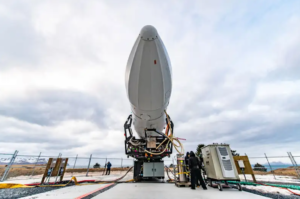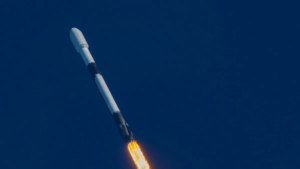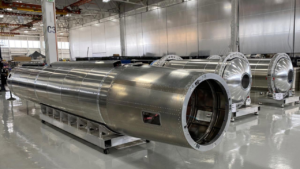
The Falcon Heavy Is Set To Launch In Just One Week
The Falcon Heavy is still the most powerful operational launch vehicle in the space industry. Not only does it hold this impressive title, but it also features partial reusability, and so much more. Unfortunately, despite all the features this heavy lift launch vehicle has going for it, it has been a few years since we last saw it launch. However, this is set to change in only days from now.
Currently, the Falcon Heavy is set to launch in only one week on the 31st of October apart of the USSF 44 mission. The mission is expected to deploy two spacecraft payloads directly into geosynchronous orbit, one of which is the military’s TETRA 1 microsatellite. While there have been a few reasons for the lack of Falcon Heavy launches over time, thankfully this cold streak is coming to an end.
Not only this, but after this first launch, the launch vehicle is scheduled for many more missions in the coming months and years. This includes a lot of firsts such as a simultaneous booster drone ship landing, among other things. Here I will go more in-depth into this upcoming mission, what to expect, the Falcon Heavy rocket, and more.
USSF 44 Mission

After a very long wait, we are only days away from a Falcon Heavy launch. Just yesterday SpaceX tweeted saying, “Falcon Heavy in the hangar at Launch Complex 39A” This included an image of the 27 Merlin engines on the bottom of the three boosters. Focusing on the schedule, this mission was originally set to happen years ago in 2020. This had to do with Space Force payload issues that were recently confirmed to be fixed and ready. Earlier this month they scheduled the launch to be on October 28th, before pushing it back to the current launch date of October 31st.
In terms of the mission, this launch is the first classified flight of Falcon Heavy. The contract was awarded to SpaceX for a price of under 30% of that of a typical Delta IV Heavy launch at only around $130 million. The payload includes two separate satellites and at least two additional rideshare payloads (including TETRA-1) and will weigh roughly 3.7 t (8,200 lb) at launch. Falcon Heavy will be launched in a direct geosynchronous orbit, necessitating for the first time a planned partially expendable launch. This means that SpaceX is going to deliberately expend the center core which lacks grid fins and landing gear needed for a landing. This being said, the two side-boosters will still be targeting simultaneous landings at the cape. The second stage will feature a gray band due to its long coast phase between subsequent burns, to allow more heat from sunlight to be absorbed to warm the RP-1 kerosene tank during the longer coasting period, a first for Falcon Heavy, and a third for any falcon rocket. When it gets too cold, kerosene – which freezes at a much higher temperature than Falcon’s liquid oxygen oxidizer – becomes viscous and slush-like before it freezes solid. If ingested, slushy fuel would likely prevent ignition or destroy the upper stage’s Merlin engine.
Within the next few days, we can expect to see this launch vehicle moved to the pad, and prepped for the launch just one week away. While exciting, this mission just marks the beginning of many more Falcon Heavy launches. Just one month later in November it’s possible we see the rocket launch again. In this case, Falcon Heavy was originally slated to launch the Viasat-2 satellite, but due to delays, an Ariane 5 launch vehicle was used instead. Viasat maintained the launch option and will launch its next Ka-band satellite, which will serve either the Asia-Pacific (APAC), Europe, Middle East and Africa (EMEA), or Americas regions, using Falcon Heavy. The upper stage of Falcon Heavy will deploy the satellite into a near-geosynchronous orbit that will include a coasting stage several hours long between burns. Keeping with the theme, just one more month later and there are even more launch opportunities. In January 2023, the first SpaceX launch of Phase 2 USAF contract is scheduled, likely to be on a Falcon Heavy, and likely requiring a vertical integration building and an increased fairing size. This launch will use three new boosters, with the center core in an expendable configuration (no grid fins or landing gear), while the two side-boosters will be targeting a simultaneous landing on drone ships, JRTI and ASOG as the mission requirements are similar as of USSF-44 mission set to happen next week. Not to mention an additional 10-plus launches that could use this rocket in the coming years.
Falcon Heavy Overview

Now that we know more about the long-awaited launch planned for next week, we can take a closer look at the launch vehicle itself and some of its past launches. The first ever Falcon Heavy launch occurred in February 2018. During this demonstration flight, a Tesla Roadster was sent to a trans-Mars injection heliocentric orbit. While both side boosters landed successfully; the center booster struck the ocean and was destroyed after two of its engines failed to relight during the landing burn. Either way, it was still considered a massive success and set the stage for what this rocket was capable of.
Just over a year later in April 2019, SpaceX launch the Falcon Heavy for a second time. Here a heavy communications satellite was purchased by the Arab League. For the first time, all three boosters landed successfully but the center core subsequently fell over and was lost during transport due to heavy seas. Like the previous mission, it was still a massive success for the company. Finally, just a few months after the second launch, the third and most recent Falcon Heavy launch occurred. The mission supported the U.S. Air Force National Security Space Launch certification process for the Falcon Heavy. The original contract price was US$165 million, which was later reduced due to the military’s agreement to fly the mission with reused side boosters. Following the same theme as the previous missions, they successfully reused and landed the boosters from the second Falcon Heavy flight, however, the center core booster failed to land successfully and was destroyed upon impact in the Atlantic Ocean. A pattern SpaceX is hoping to change in various future launches.
With Falcon Heavy’s history in mind, we can now focus on the launch vehicle itself and why it’s so special even today. Falcon Heavy is the most powerful operational rocket in the world by a factor of two. With the ability to lift into orbit nearly 64 metric tons (141,000 lb) Falcon Heavy can lift more than twice the payload of the next closest operational vehicle, the Delta IV Heavy. Falcon Heavy is composed of three Falcon 9 nine-engine cores whose 27 Merlin engines together generate more than 5 million pounds of thrust at liftoff, equal to approximately eighteen 747 aircraft. Standing at 70 meters tall, this launch vehicle has a payload capacity to low Earth orbit of 63,800 kilograms and 26,700 to geosynchronous orbit.
One of the most fascinating parts about Falcon Heavy and an original design challenge for SpaceX has to do with the three side by side boosters. The fundamental purpose of the side cores is to apply axial force to the center core during ascent and increase the impulse delivered to the second stage before stage separation. The timing of the shutdown for the Falcon Heavy side cores can be tailored for each mission to ensure that the proper impulse is delivered. Each side core is structurally connected to the center core at forward and aft locations. Two pneumatic pusher separation mechanisms connect the forward ends of each side core to the center core, fastening the top of the LOX tank in the center core to the side cores. They maintain the connection during ascent and then actively jettison the side cores following side core shutdown. Two identical pusher separation mechanisms connect the aft ends of each side core to the center core and are used to laterally force the base of the side cores from the center core following the side core shut down.
The first-stage propellant tank walls of the Falcon vehicles are made from an aluminum lithium alloy. Tanks are manufactured using friction stir welding—the highest strength and most reliable welding technique available. A common dome separates the LOX and RP-1 tanks, and a double-wall transfer tube carries LOX through the center of the RP-1 tank to the engine section. Four grid fins near the top of the first stage along with four deployable legs at the base are nominally flown to support recovery operations. In other words, three cores make up the first stage of Falcon Heavy. The side cores, or boosters, are connected on the nosecone, the interstage, and on the octaweb. Shortly after liftoff, the center core engines are throttled down. After the side cores separate, the center core engines throttle back up to full thrust. This intricate system works together perfectly to ensure a successful mission and eventually the landing on all three boosters.
Conclusion
The Falcon Heavy is one of the most fascinating launch vehicles in the space industry. Between its power and partial reusability, it’s very unique and exciting to watch. While it’s been years since we last saw it launch, this is set to change in only a week from now on October 31st. We will have to wait and see how it progresses and the impact it has on the space industry.



